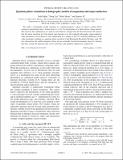| dc.contributor.author | Liu, Hong | |
| dc.contributor.author | Iqbal, Nabil | |
| dc.contributor.author | Mezei, Mark Koppany | |
| dc.contributor.author | Si, Qimiao | |
| dc.date.accessioned | 2011-02-04T15:11:23Z | |
| dc.date.available | 2011-02-04T15:11:23Z | |
| dc.date.issued | 2010-08 | |
| dc.date.submitted | 2010-05 | |
| dc.identifier.issn | 1550-7998 | |
| dc.identifier.issn | 1550-2368 | |
| dc.identifier.uri | http://hdl.handle.net/1721.1/60895 | |
| dc.description.abstract | We study a holographic model realizing an “antiferromagnetic” phase in which a global SU(2) symmetry representing spin is broken down to a U(1) by the presence of a finite electric charge density. This involves the condensation of a neutral scalar field in a charged anti–de Sitter black hole. We observe that the phase transition for both neutral and charged (as in the standard holographic superconductor) order parameters can be driven to zero temperature by a tuning of the UV conformal dimension of the order parameter, resulting in a quantum phase transition of the Berezinskii-Kosterlitz-Thouless–type. We also characterize the antiferromagnetic phase and an externally forced ferromagnetic phase by showing that they contain the expected spin waves with linear and quadratic dispersions, respectively. | en_US |
| dc.description.sponsorship | United States. Dept. of Energy (DE-FG0205ER41360, OJI program) | en_US |
| dc.description.sponsorship | National Science Foundation (U.S.) (DE-FG0205ER41360) | en_US |
| dc.description.sponsorship | Robert A. Welch Foundation (Grant No. C-1411) | en_US |
| dc.language.iso | en_US | |
| dc.publisher | American Physical Society | en_US |
| dc.relation.isversionof | http://dx.doi.org/10.1103/PhysRevD.82.045002 | en_US |
| dc.rights | Article is made available in accordance with the publisher's policy and may be subject to US copyright law. Please refer to the publisher's site for terms of use. | en_US |
| dc.source | APS | en_US |
| dc.title | Quantum phase transitions in holographic models of magnetism and superconductors | en_US |
| dc.type | Article | en_US |
| dc.identifier.citation | Iqbal, Nabil et al. “Quantum phase transitions in holographic models of magnetism and superconductors.” Physical Review D 82.4 (2010): 045002. © 2010 The American Physical Society. | en_US |
| dc.contributor.department | Massachusetts Institute of Technology. Center for Theoretical Physics | en_US |
| dc.contributor.department | Massachusetts Institute of Technology. Department of Physics | en_US |
| dc.contributor.approver | Liu, Hong | |
| dc.contributor.mitauthor | Liu, Hong | |
| dc.contributor.mitauthor | Iqbal, Nabil | |
| dc.contributor.mitauthor | Mezei, Mark Koppany | |
| dc.contributor.mitauthor | Si, Qimiao | |
| dc.relation.journal | Physical Review D | en_US |
| dc.eprint.version | Final published version | en_US |
| dc.type.uri | http://purl.org/eprint/type/JournalArticle | en_US |
| eprint.status | http://purl.org/eprint/status/PeerReviewed | en_US |
| dspace.orderedauthors | Iqbal, Nabil; Liu, Hong; Mezei, Márk; Si, Qimiao | en |
| dc.identifier.orcid | https://orcid.org/0000-0002-4911-3183 | |
| mit.license | PUBLISHER_POLICY | en_US |
| mit.metadata.status | Complete | |
